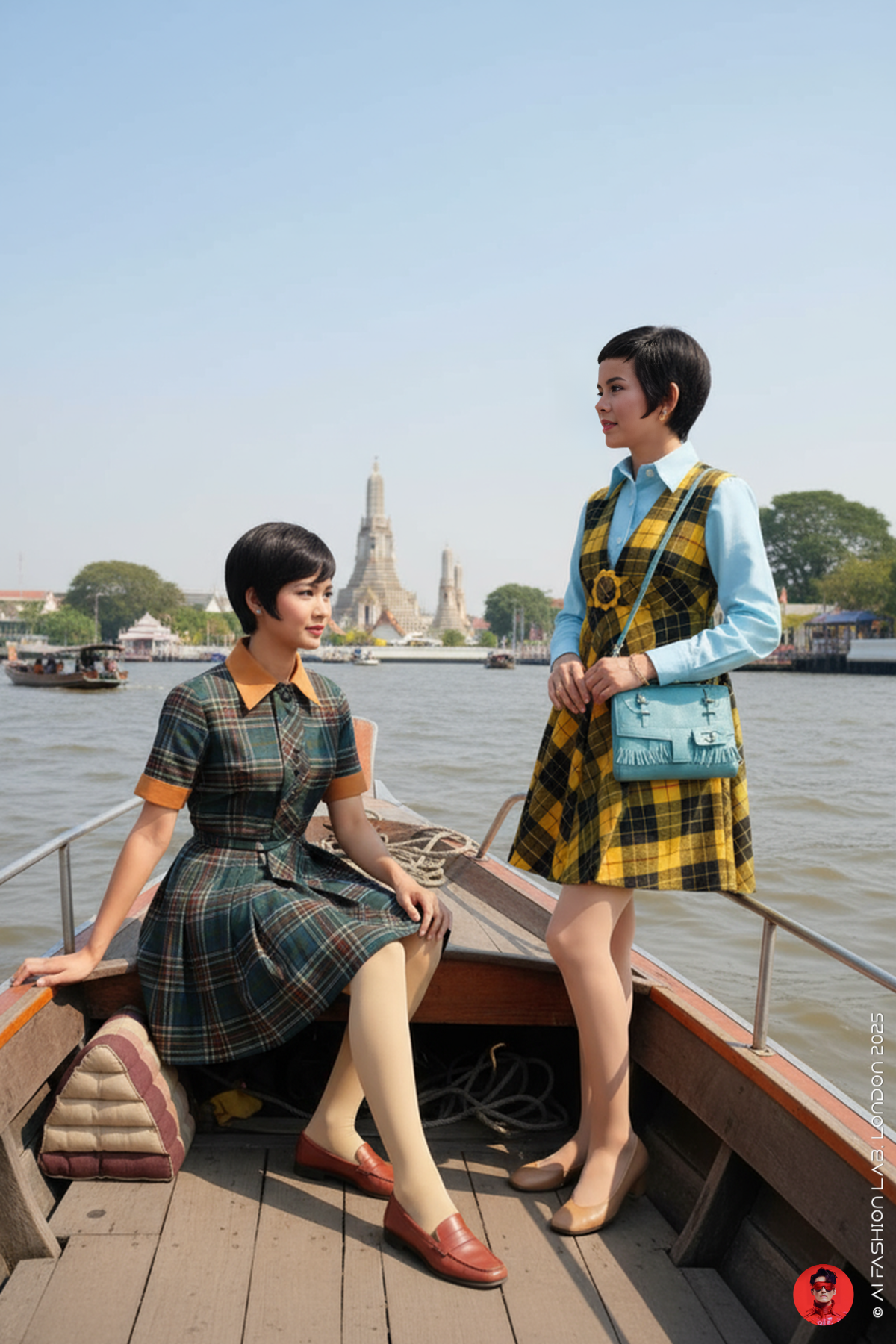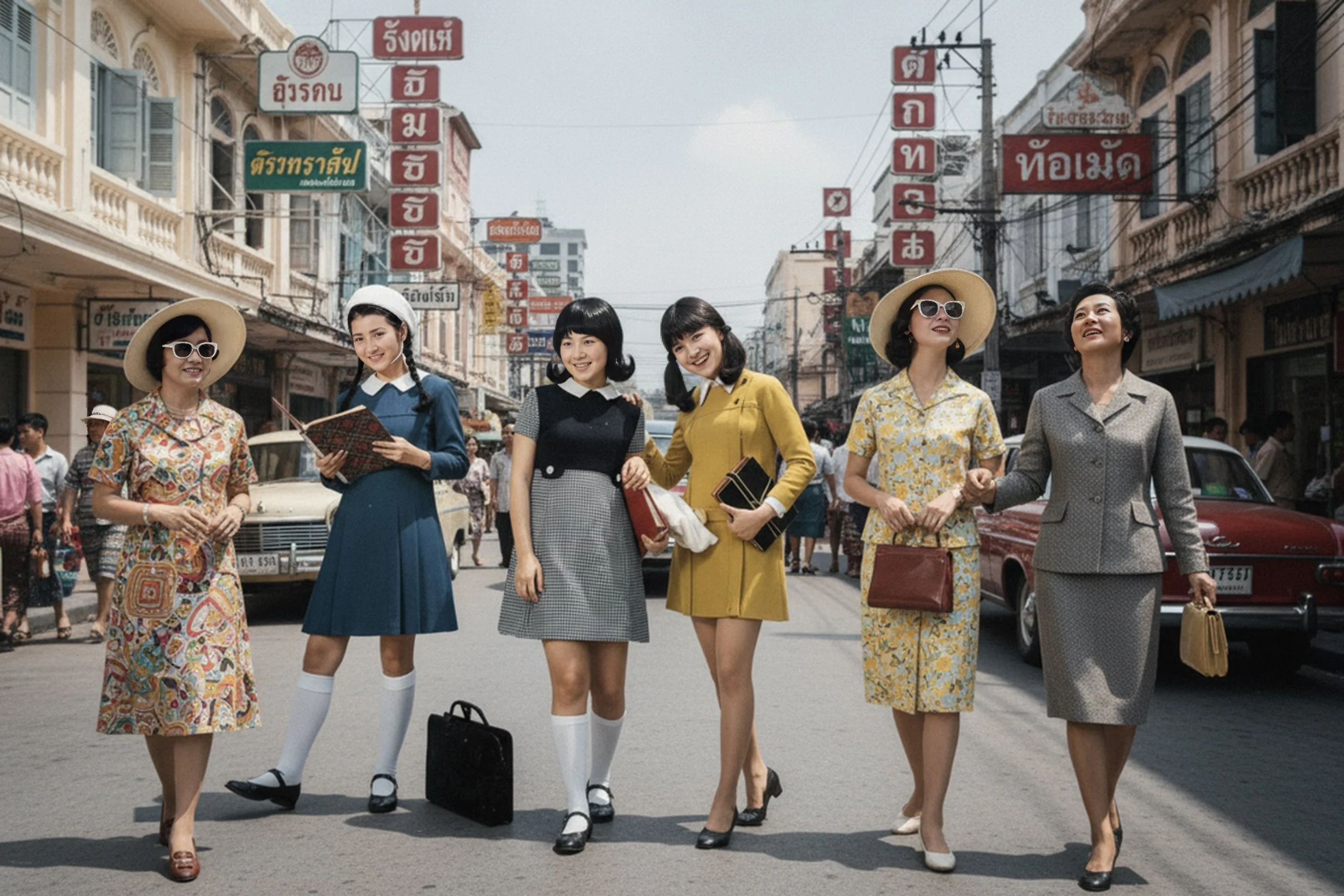แฟชั่นกรุงเทพฯ ยุค 1960s (พ.ศ. 2510): สะพานเชื่อมระหว่างวัฒนธรรมไทยและตะวันตก
แฟชั่นกรุงเทพฯ ยุค 1960s (พ.ศ. 2510): สะพานเชื่อมระหว่างวัฒนธรรมไทยและตะวันตก
แรงบันดาลใจของคอลเล็กชัน AI นี้มาจากความหลงใหลในเสน่ห์ของวงการภาพยนตร์ไทยใน ทศวรรษ 1960 (พุทธศักราช 2503-2512) ซึ่งเป็นยุคที่แฟชั่นของไทยเปลี่ยนแปลงไปอย่างมีเอกลักษณ์ ด้วยอิทธิพลของวัฒนธรรมตะวันตกที่ผสมผสานกับรากเหง้าไทยอย่างงดงาม วงการภาพยนตร์ไทยในยุคนั้นเป็นตัวแทนของความงามและสไตล์การแต่งกาย โดยมีดาราดังอย่าง เพชรา เชาวราษฎร์ และ อรัญญา นามวงศ์ เป็นไอคอนด้านแฟชั่นที่ได้รับการยกย่องว่าเป็นต้นแบบความงามของผู้หญิงไทย
เพื่อสร้างสรรค์ภาพลักษณ์ที่สมจริงของแฟชั่นยุค 60s ขึ้นมาใหม่ผ่าน AI ผมได้ฝึกโมเดล LoRA โดยใช้ภาพถ่ายจากนิตยสารและภาพยนตร์เก่าของไทยในการสร้างสรรภาพ เพื่อให้ได้ผลลัพธ์ที่แม่นยำที่สุด รายละเอียดทุกอย่าง ไม่ว่าจะเป็น ทรงผม การแต่งหน้า ผ้า และสไตล์ของภาพถ่าย ถูกออกแบบมาให้สะท้อนถึงยุคสมัยอย่างแท้จริง เป้าหมายของคอลเล็กชันนี้คือการสร้างภาพถ่ายในสไตล์วินเทจ ให้ดูเหมือนภาพถ่ายในนิตยสารของสมัยนั้น
คอลเล็กชัน AI นี้ไม่ได้เป็นเพียงแค่การทดลองด้านศิลปะ แต่เป็นการแสดงความเคารพต่อมรดกทางแฟชั่นและภาพยนตร์ไทยในยุคที่รุ่งเรืองที่สุด รูปแบบของแฟชั่นไทยในยุค 1960s เป็นผลลัพธ์ของการหลอมรวมระหว่างความคลาสสิกของไทยและความทันสมัยจากโลกตะวันตก ซึ่งยังคงเป็นแรงบันดาลใจให้กับนักออกแบบแฟชั่นและคนรักแฟชั่นจนถึงปัจจุบัน
ในทศวรรษ 1960 หรือ ช่วงเวลาระหว่างปี พ.ศ. 2503-2512 ประเทศไทยอยู่ในช่วงหัวเลี้ยวหัวต่อของความเปลี่ยนแปลงทั้งในด้านสังคม การเมือง และวัฒนธรรม กรุงเทพฯ ในเวลานั้นเป็นศูนย์กลางของความทันสมัยที่ได้รับอิทธิพลจากโลกตะวันตกอย่างรวดเร็ว ภายใต้รัชสมัยของ พระบาทสมเด็จพระปรมินทรมหาภูมิพลอดุลยเดชฯ (รัชกาลที่ 9) ซึ่งครองราชย์ตั้งแต่ พ.ศ. 2489 จนถึง พ.ศ. 2559 ในช่วงเวลานี้ประเทศไทยมีความสัมพันธ์อันแน่นแฟ้นกับชาติตะวันตก โดยเฉพาะสหรัฐอเมริกา ส่งผลให้กระแสแฟชั่นตะวันตกแพร่หลายอย่างรวดเร็ว ขณะเดียวกัน ไทยก็ยังคงรักษาอัตลักษณ์ของตนเองผ่านแฟชั่นที่ปรับให้เข้ากับบริบทท้องถิ่น
ทศวรรษ 1960 ถือเป็นยุคทองของภาพยนตร์ไทย หนังไทยเฟื่องฟูและกลายเป็นสื่อสำคัญที่เผยแพร่กระแสแฟชั่นใหม่ไปทั่วประเทศ ดาราภาพยนตร์อย่าง เพชรา เชาวราษฎร์ อรัญญา นามวงศ์ รุจน์ รณภพ และมิตร ชัยบัญชา เป็นนักแสดงที่ได้รับความนิยม และเป็นแบบอย่างด้านแฟชั่นให้แก่ผู้ชมทั่วประเทศ
วัฒนธรรมตะวันตกกับความเฟื่องฟูของแฟชั่นยุค 1960s
ในโลกตะวันตก ยุค 1960s เป็นยุคของการปฏิวัติแฟชั่น เมืองหลวงของโลกแฟชั่นในขณะนั้นมีทั้ง ปารีส ลอนดอน นิวยอร์ก และมิลานโดยแต่ละเมืองมีสไตล์ที่แตกต่างกันออกไป ในช่วงต้นทศวรรษ 1960 (พ.ศ. 2503-2505) สไตล์ของยุค 1950s ยังคงเป็นที่นิยม หญิงสาวยังคงสวมชุดเดรสที่เข้ารูปช่วงเอว กระโปรงทรงสุ่ม (Full Skirt) และเสื้อเบลาส์ที่ออกแบบมาเพื่อเน้นสัดส่วนของร่างกาย
แต่เมื่อเข้าสู่กลางทศวรรษ (พ.ศ. 2506-2508) กระแสการปฏิวัติแฟชั่นของวัยรุ่น (Youthquake) ได้เปลี่ยนแปลงทุกอย่าง ลอนดอน กลายเป็นเมืองแห่งแฟชั่นยุคใหม่ นักออกแบบสาวชาวอังกฤษ แมรี่ ควอนต์ (Mary Quant) ได้สร้างประวัติศาสตร์ด้วยการออกแบบ มินิสเกิร์ต (กระโปรงสั้นเหนือเข่า) ซึ่งสั้นเหนือเข่าและแสดงออกถึงอิสรภาพของผู้หญิงยุคใหม่
ขณะเดียวกัน ปารีส ยังคงเป็นศูนย์กลางของแฟชั่นชั้นสูง (Haute Couture) ดีไซเนอร์เช่น อีฟส์ แซงต์ โลรองต์ (Yves Saint Laurent) และปิแอร์ การ์แดง (Pierre Cardin) ได้ปฏิวัติวงการแฟชั่นด้วยดีไซน์ที่ล้ำสมัยแบบ สเปซเอจ (Space Age Fashion) เสื้อผ้าเน้นเส้นสายที่คมชัด วัสดุเงาวาว และโครงสร้างแบบเรขาคณิต
อเมริกา ในยุคนี้เต็มไปด้วยเสน่ห์ของ ฮอลลีวูด ที่ส่งอิทธิพลมาถึงประเทศไทยอย่างไม่ต้องสงสัย ภาพลักษณ์ของ ออเดรย์ เฮปเบิร์น (Audrey Hepburn), เอลิซาเบธ เทย์เลอร์ (Elizabeth Taylor) และบริจิตต์ บาร์โดต์ (Brigitte Bardot) สร้างแรงบันดาลใจให้แก่หญิงสาวทั่วโลก ทั้งในแง่ของแฟชั่น ทรงผม และการแต่งหน้า
แฟชั่นกรุงเทพฯ: จุดเชื่อมระหว่างไทยและตะวันตก
แฟชั่นของกรุงเทพฯ ในยุค 1960s เป็นสิ่งที่สะท้อนถึงสังคมไทยที่กำลังเปลี่ยนผ่านจากความเป็นไทยดั้งเดิมสู่ความเป็นสากล เสื้อผ้าไทยในอดีต เช่น สไบ ผ้านุ่ง และโจงกระเบน ยังคงปรากฏให้เห็นในงานราชพิธีและงานสำคัญ แต่ในชีวิตประจำวัน ผู้หญิงไทยเริ่มสวมใส่เสื้อผ้าสไตล์ตะวันตกมากขึ้น
ชุดเดรสที่เน้นสัดส่วน เอวคอด และกระโปรงสุ่มแบบยุโรป เป็นที่นิยมในช่วงต้นทศวรรษ แต่เมื่อวัฒนธรรมอังกฤษเริ่มเข้ามา มินิสเกิร์ต ก็ได้รับความนิยมอย่างแพร่หลาย โดยเฉพาะในหมู่สาววัยรุ่นในเมืองที่ต้องการก้าวให้ทันสมัย
หนึ่งในจุดเปลี่ยนสำคัญคือ การตอบรับแฟชั่นมินิสเกิร์ต ซึ่งถือเป็นเรื่องใหม่สำหรับสังคมไทย ภาพของดาราภาพยนตร์ไทย หรือคนในสังคมชั้นสูง เช่น มาลาริน บุนนาค ในชุดมินิเดรส กลายเป็นต้นแบบแฟชั่นสำหรับหญิงสาวทั่วประเทศ สีสันสดใส ลายกราฟิก และกระดุมเม็ดใหญ่ กลายเป็นดีไซน์ยอดนิยมในยุคนั้น
มาตรฐานความงามของหญิงไทยในทศวรรษ 1960
ทศวรรษ 1960 ถือเป็นช่วงเวลาแห่งการเปลี่ยนผ่านของความงามและแฟชั่นในประเทศไทย ซึ่งได้รับอิทธิพลทั้งจากโลกตะวันตกและเอกลักษณ์แบบไทยดั้งเดิมอย่างลงตัว มาตรฐานความงามในยุคนั้นแตกต่างจากปัจจุบันอย่างชัดเจน — หญิงสาวที่มีรูปร่างอวบอิ่ม เอวคอด และสะโพกผายถือเป็นอุดมคติของความงาม ขณะที่รูปร่างผอมเพรียวแบบนางแบบในปัจจุบันยังไม่ใช่แนวทางหลักของยุคนั้น
ทรงผมของหญิงไทยยุค 1960s สะท้อนรสนิยมที่หรูหราและละเอียดอ่อน ได้รับอิทธิพลจากดาราฮอลลีวูดอย่างเอลิซาเบธ เทย์เลอร์ และออเดรย์ เฮปเบิร์น รวมถึงจากสตรีไทยในราชสำนักและวงสังคมชั้นสูง ทรงผมที่ได้รับความนิยมมากได้แก่ ทรงบูฟฟองต์ (Bouffant) ซึ่งเน้นการยีผมให้พองสูงด้านบน ดูสง่างามและมีบุคลิกที่มั่นใจ นอกจากนี้ยังนิยมการดัดลอนอ่อนหรือม้วนปลายผมให้เป็นคลื่นอย่างมีเสน่ห์
การแต่งหน้าในยุคนั้นได้รับอิทธิพลจากฮอลลีวูดเช่นกัน โดยเฉพาะการกรีดอายไลเนอร์เส้นหนา ขนตางอนเด้ง และลิปสติกสีแดงสดที่ช่วยขับให้ใบหน้าดูโดดเด่นและมีพลัง
💈 ทรงผมยอดนิยมของหญิงไทยยุค 1960s
ทรงพองปลายกระดก (Bouffant) – ยีผมด้านบนให้พองสูง ปลายผมม้วนออก ดูสง่างามและร่วมสมัย
ทรงรังผึ้ง (Beehive) – เกล้าผมสูงเป็นทรงรังผึ้ง มักตกแต่งด้วยมงกุฎขนาดเล็กหรือต่างหูระย้า
ทรงบ๊อบปลายกระดก (Flipped Bob) – ทรงบ๊อบสั้นปลายม้วนออก ให้ลุคทันสมัยและคล่องแคล่ว
ทรงครึ่งศีรษะ (Sleek Half-Up) – ปล่อยผมครึ่งหนึ่งแล้วยีด้านบนให้พอง อาจคาดผมหรือประดับโบว์เล็ก
บ๊อบลอนสั้น (Curled Short Bob) – ผมสั้นม้วนแน่น ดูอ่อนวัย เรียบร้อย และเป็นที่นิยมในหมู่นักเรียนหญิง
ลอนอ่อนกับหน้าม้า (Soft Curls with Bangs) – ลอนนุ่มพลิ้วกับหน้าม้าอ่อนหวาน ช่วยขับลุคให้ดูอ่อนโยนและสดใส
แฟชั่น 1960s และมรดกที่ยังคงอยู่
แม้ว่าทศวรรษ 1960 จะผ่านไปนานหลายปี แต่แฟชั่นของยุคนี้ยังคงเป็นแรงบันดาลใจให้กับดีไซเนอร์ไทยในปัจจุบัน มินิเดรสทรงเอไลน์ ชุดเดรสลายกราฟิก และเสื้อผ้าแนวเรโทร ยังคงปรากฏอยู่บนรันเวย์และในวงการบันเทิง
ยุค 1960 ไม่ได้เป็นเพียงช่วงเวลาของแฟชั่น แต่เป็นช่วงเวลาแห่งการเปลี่ยนแปลงทางสังคม ความเป็นไทยและความเป็นสากลได้มาบรรจบกันในรูปแบบที่ลงตัวที่สุด กรุงเทพฯ ในยุคนั้นจึงเป็นภาพสะท้อนของสังคมไทยที่เปิดรับโลกภายนอก ขณะเดียวกันก็ยังคงรักษาเอกลักษณ์ของตนเองไว้ แฟชั่นในยุคนี้เป็นมากกว่าเสื้อผ้า แต่คือเรื่องราวของความทันสมัย อิสรภาพ และการหลอมรวมทางวัฒนธรรม ที่ยังคงมีอิทธิพลมาจนถึงทุกวันนี้
______________________________________
Bangkok Fashion in the 1960s (B.E. 2510): A Bridge Between Thai and Western Culture
The inspiration for this AI collection stems from my fascination with the golden era of Thai cinema in the 1960s (B.E. 2503–2512), a time when Thailand’s fashion evolved with a unique identity that beautifully blended Western influences with Thai roots. The Thai film industry of that decade became the emblem of beauty and style, with movie stars such as Petchara Chaowarat (เพชรา เชาวราษฎร์) and Aranya Namwong (อรัญญา นามวงศ์) emerging as fashion icons, admired as the epitome of Thai femininity.
To recreate the authentic fashion aesthetics of the 1960s through AI, I trained a LoRA model using reference images from vintage Thai magazines and films. Every element—from hairstyles, makeup, and fabrics to photographic composition—was meticulously designed to reflect the visual language of the period. The goal of this collection was to generate vintage-style portraits that resemble fashion magazine photographs from the time.
This AI collection is not merely an artistic experiment, but a tribute to the legacy of Thai fashion and cinema during one of its most prosperous eras. The fashion of 1960s Thailand represented a harmonious fusion of traditional Thai elegance and Western modernity—a dialogue that continues to inspire designers and fashion enthusiasts today.
1960s Thailand: An Era of Cultural Transformation
The 1960s (B.E. 2503–2512) marked a pivotal period of social, political, and cultural transition in Thailand. Bangkok (กรุงเทพฯ) emerged as the centre of modernity, rapidly absorbing Western influences. Under the reign of His Majesty King Bhumibol Adulyadej (พระบาทสมเด็จพระปรมินทรมหาภูมิพลอดุลยเดชฯ, King Rama IX), who ruled from 1946 to 2016 (B.E. 2489–2559), Thailand strengthened its ties with the Western world—particularly with the United States. This international connection accelerated the spread of Western fashion trends, even as Thai designers and wearers adapted them to suit local sensibilities.
The 1960s was also the golden age of Thai cinema, when films flourished and became a major channel through which new fashion trends reached audiences nationwide. Stars such as Petchara Chaowarat (เพชรา เชาวราษฎร์), Aranya Namwong (อรัญญา นามวงศ์), Ruj Ronnapop (รุจน์ รณภพ), and Mit Chaibancha (มิตร ชัยบัญชา) defined glamour and sophistication, serving as influential fashion role models.
Western Influence and the Global Fashion Revolution
In the West, the 1960s was a decade of fashion revolution. The world’s style capitals—Paris, London, New York, and Milan—each cultivated distinct aesthetics.
In the early years of the decade (B.E. 2503–2505), fashion retained its 1950s elegance: fitted waists, full skirts, and feminine silhouettes.
By the mid-1960s (B.E. 2506–2508), however, the Youthquake movement reshaped everything. London became the epicentre of youth culture, with British designer Mary Quant (แมรี่ ควอนต์) revolutionising women’s fashion through her invention of the miniskirt (มินิสเกิร์ต)—a bold, knee-revealing design that symbolised freedom and modern womanhood.
Meanwhile, Paris continued to lead in haute couture, with designers like Yves Saint Laurent (อีฟส์ แซงต์ โลรองต์) and Pierre Cardin (ปิแอร์ การ์แดง) introducing futuristic Space Age designs featuring sleek lines, shiny materials, and geometric silhouettes.
In Hollywood, American glamour captivated audiences worldwide. Icons such as Audrey Hepburn (ออเดรย์ เฮปเบิร์น), Elizabeth Taylor (เอลิซาเบธ เทย์เลอร์), and Brigitte Bardot (บริจิตต์ บาร์โดต์) inspired women globally—including in Thailand—through their chic hairstyles, bold makeup, and graceful presence on screen.
Bangkok Fashion: The Intersection of Thai and Western Style
Bangkok fashion in the 1960s reflected a society in transition—from traditional Thai aesthetics to international modernity. Traditional garments such as the sabais (สไบ), pha-nung (ผ้านุ่ง), and jong kraben (โจงกระเบน) remained present at royal ceremonies and formal events, yet in daily life, Thai women increasingly embraced Western clothing.
In the early 1960s, fitted dresses with cinched waists and flared skirts were popular, inspired by European silhouettes. As British culture gained influence, the miniskirt quickly captured the imagination of urban women who sought to express youth and independence.
One of the defining fashion moments of the decade was the public acceptance of the miniskirt—a daring symbol of modernity in conservative Thai society. Photographs of Thai actresses and socialites, such as Malarin Bunnag (มาลาริน บุนนาค) in a mini dress, set trends nationwide. Bright colours, geometric prints, and oversized buttons became hallmarks of the era’s design.
Thai Standards of Beauty in the 1960s
The 1960s marked a transformation in Thai ideals of beauty and femininity. While Western influences introduced new aesthetics, Thai women preserved a graceful, soft allure distinct from the slender fashion models of today. The ideal woman was curvaceous, with a slim waist and rounded hips, symbolising health and elegance rather than thinness.
Thai hairstyles of the decade showcased both sophistication and local charm. Influenced by Hollywood stars like Elizabeth Taylor and Audrey Hepburn, as well as by royal and high-society women in Thailand, the following styles became popular:
💈 Popular Hairstyles Among Thai Women in the 1960s
Bouffant (ทรงพองปลายกระดก) – Hair teased high on top and flipped at the ends, exuding poise and elegance.
Beehive (ทรงรังผึ้ง) – A tall, sculpted updo often paired with a small tiara or chandelier earrings.
Flipped Bob (ทรงบ๊อบปลายกระดก) – Short bob with outward-curled ends for a chic, youthful look.
Sleek Half-Up (ทรงครึ่งศีรษะ) – Hair half-up with volume on top, often styled with a headband or ribbon.
Curled Short Bob (บ๊อบลอนสั้น) – Tightly curled short hair giving a neat, schoolgirl charm.
Soft Curls with Bangs (ลอนอ่อนกับหน้าม้า) – Gentle waves and soft bangs for a sweet, youthful appeal.
Makeup followed Hollywood trends, featuring bold eyeliner, long lashes, and bright red lipstick—an empowering combination that conveyed confidence and allure.
The Enduring Legacy of 1960s Thai Fashion
Though decades have passed, the fashion of 1960s Bangkok continues to inspire Thai designers today. A-line mini dresses, graphic prints, and retro silhouettes remain timeless on modern runways and in film.
The 1960s represented more than just a fashion era—it was a social awakening. Thai identity and international modernity converged in perfect harmony, turning Bangkok into a vivid reflection of a nation embracing global change while preserving its own essence.
Fashion of this era was more than mere clothing—it was a statement of modernity, freedom, and cultural fusion, whose influence continues to shape Thai aesthetics to this day.
#aifashionlab #AI #aiartist #aiart #aifashion #aifashiondesign #aifashionstyling #aifashiondesigner #fashion #fashionhistory #historyoffashion #fashionstyling #fashionphotography #digitalfashion #digitalfashiondesign #digitalcostumedesign #digitaldesign #digitalaiart #ThaiFashionHistory #ThaiFashionAI #flux #fluxlora




























































